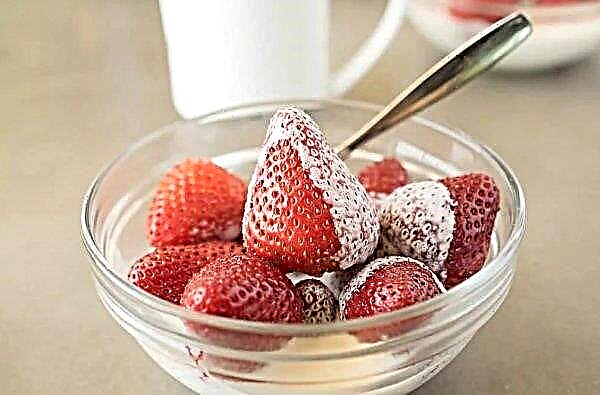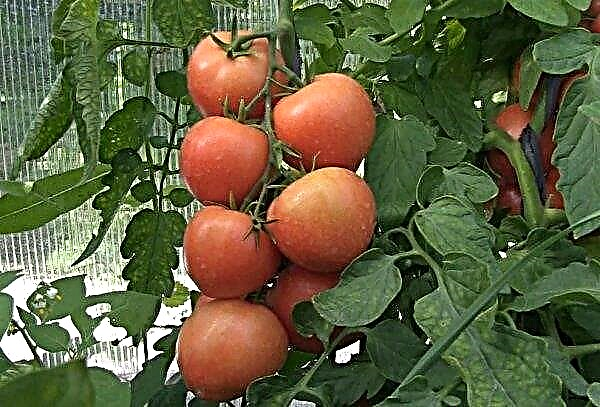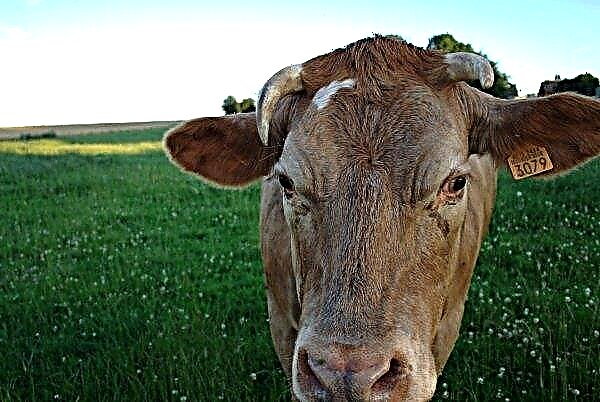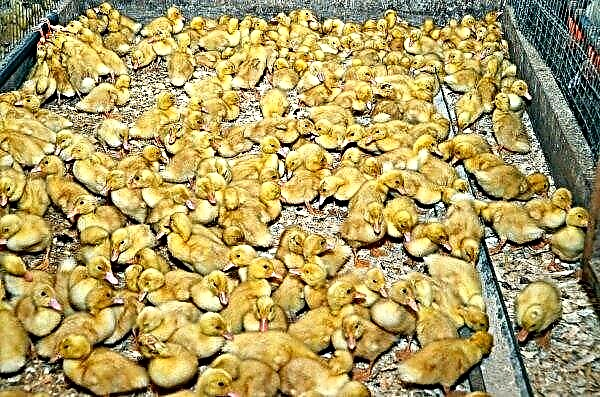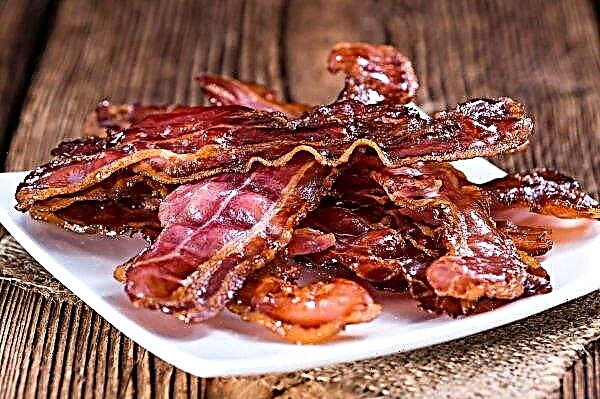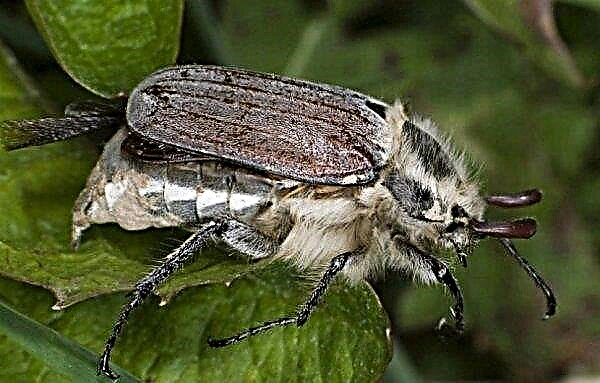Dwarf rabbits are excellent picky pets who, living peacefully in cages, do not spoil furniture or other household items, as is often the case with cats or dogs. In this article, a detailed description of the Dutch lop-eared rabbit of a ram and features of keeping the animal at home will be considered.
Story
The breed of Dutch fold rabbit is quite popular in the modern world. The breeder Adrian de Kock began to engage in the breeding process in 1952. Breeding was rather complicated, since the main problem of breeding dwarf breeds of lop-eared rabbits is that ears are also reduced in the process of reducing the size of animals, therefore it is very difficult to achieve lop-eared.
For breeding, such breeds as the Dutch ram and the ordinary rabbit were used, but the result was not achieved the first time. The selection process lasted a long 11 years. The breed was officially recognized in 1964.
Did you know? The dwarf fold animal got its name “rabbit-ram” due to its massive head and wide slightly convex forehead, which very much resemble the head of a lamb.
Breed description
Different breeds of decorative rabbits differ not only in appearance but also in character, they have certain advantages and disadvantages, which must be familiarized with.
Breed standard
Each breed of decorative dwarf fold rabbits has its own characteristic features of appearance, which make it possible to distinguish it from other breeds. Therefore, we consider a detailed description of the breed standard in the form of a table.
| Appearance | Characteristic |
| Color | White, black, gray, brown, beige. Can combine several colors and their shades |
| Weight | Up to 1,5 kg |
| Torso | Cylindrical, with a wide chest, short neck, rounded back |
| Head | Massive, with a wide convex forehead, puffy cheeks |
| Paws | Forefeet - short, thick, hind legs - long, thinner |
| Tail | Miniature, snug against the body |
| The ears | Long - 21–28 cm, hanging |
| Eyes | Large, widely planted |
| Claws | Small, strong and sharp |
| Fur length | Up to 1.5 cm |
Character
Rabbits of this breed are very calm, quickly adapt to new living conditions, get along well with people, so they are perfectly suited for pets as pets. They happily go hand in hand, let themselves stroke, adore active games.
Despite the fact that rabbits themselves are shy animals, Dutch fold sheep are quite bold and are not afraid of harsh sounds (this is due to the physiological peculiarity - drooping ears that muffle the sound a little).

Advantages and disadvantages
- Among the advantages of ram rabbits are:
- miniature, so you can keep them in small apartments;
- ease of care and pickiness in nutrition;
- quick accustoming to the tray when going to the toilet, which greatly simplifies the cleaning process;
- flexible, non-aggressive character;
- Beautiful decorative appearance.
- the disadvantages of the breed include:
- the high cost of the cage and all related accessories for the maintenance and care of the pet;
- the need for daily cleaning of the rabbit’s home, regular monitoring of food and water;
- the pet’s tendency to gnaw everything that comes in the way (this fact is taken into account when organizing the pet’s walking outside the cage);
- specific smell;
- regular molting, which forces you to clean the cage and around it several times a day;
- pet activity at night, which can interfere with a relaxing holiday.
Content Features
Like any other pets, rabbits must be provided with their own housing and all the necessary attributes for a normal existence.

Cell
To make rabbits feel comfortable, it is necessary to equip them with a corner. A suitable cage should be purchased for this. The dimensions of the dwelling for this breed are of great importance, since rabbits are quite mobile creatures and they need free space for activity during the day, therefore it is better to choose a cage at least 70 cm in length and 50 cm in width.
Since the habitual habitat of the rabbit in the wild is a hole, the cage must be equipped with a closed house, where the animal will be for the first time most of the day, adapting to new conditions.In such a house, the animal will feel comfortable and protected. It is better if the cage has two floors: on the top floor the animal will rest and sleep, and on the first floor - eat and be active. Sawdust in granules or compressed in a special way is poured onto the bottom of the cells.
To place a house with a rabbit is better in a secluded place, with good lighting, protection from drafts. The optimum temperature for the content is from +10 to +20 ° C. The humidity in the room is best maintained at 60%.

Dwarf fold sheep are quite disciplined about going to the toilet and are used to doing this in a certain corner of the cage. Therefore, before installing the tray, it is better to observe the animal and calculate the "desired" angle. As a toilet, special corner or ordinary cat trays can be used.
For food and water use ceramic heavy dishes (special containers), which can be bought in specialized stores. Such dishes are necessary so that rabbits cannot bite or turn it over.
Important! It is not allowed that the air temperature rises above +25 ° C, in this case the animal will feel uncomfortable and may get sick.
Care Rules
The breed has a not very long soft coat, so it is easy to care for it. During the period of natural molting of animals (spring and autumn), it is recommended to comb the hair using a soft brush. This procedure will prevent the possibility of swallowing wool by rabbits in the process of caring for themselves. The procedure is performed once a week.

In addition to cleaning the fur, it is also necessary to pay attention to the ears of the animal and carry out their regular cleaning. The procedure should be performed at least 3 times a week. To do this, use a cotton pad soaked in peroxide. Also, at least once every two months, it is necessary to trim the claws of the pet using special claws.
Feeding
The basis of good health and well-being is a quality balanced diet. Small rabbits, up to 6 months old, are recommended to give only grain and grain mixtures, once or twice a day, depending on age (up to one year, give 2 times a day, in small portions, after 1 year - once a day, in the morning )
The basis of the diet of rabbits of any age is hay. It is poured in sufficient quantity so that rabbits have something to chew throughout the day.

- apples
- carrot;
- asparagus
- broccoli;
- cucumbers
- bananas
- celery;
- cauliflower;
- spinach;
- Tomatoes
- green turnips.
Mineral stone is also added to the diet, which serves as a source of necessary vitamins and minerals. Typically, the stone is attached to the rods of the cage so that it is convenient for the rabbit to nibble it. In addition to food, clean fresh water should always be in the cage. It is better to give water at room temperature and regularly change it to clean.

Possible diseases
Dutch lop-eared sheep can get sick:
- viral hemorrhagic disease - infection occurs when in contact with a sick animal;
- gastrointestinal stasis, which occurs as a result of stress, poor diet, or hair getting into the stomach;
- urinary dermatitis, which is characterized by loss of hair in the genital area and on the hind legs, redness of the skin;
- coccidiosis, which occurs in an animal under the influence of parasites, in this case a very high mortality rate;
- myxomatosis, which is characterized by a deterioration in appetite, heavy breathing, swelling of the eyelids, pus in the eyes, carriers of the disease - fleas and lice;
- pasteurellosis - infection occurs after contact with sick animals, the disease is characterized by a deterioration in appetite, rapid breathing, and diarrhea.
Vaccinations
Usually, rabbits are vaccinated against myxomatosis and viral hemorrhagic disease. The first vaccination is given when the animal has reached the age of 45 days and has a weight of 500 g. The vaccination can be obtained at a veterinary pharmacy, it is usually complex (for both diseases).
If you were not able to get a complex vaccine, then you are first given an injection from myxomatosis, and after 10 days from a hemorrhagic disease. The next vaccination is carried out at the age of 4.5 months, then the vaccine is administered every six months.
If you plan to travel with a rabbit, then he definitely needs to get a rabies vaccination with entry in the veterinary passport, as the employees of the airport or train station will check for its presence.

Propagation Features
When breeding decorative dwarf fold rabbits, the sex of individuals is primarily determined. This can be done no earlier than 4 months of age. In order to find out the sex, individuals are turned over on their back and tail pulled: if you have a male in front of you, you will notice small tubercles, and at a distance of 4 mm from the anus there will be a round sexual opening, but the female has a gap near the anal opening.
Rabbits can breed throughout the year (females give offspring from 6 to 9 times), with each litter has from 2 to 16 cubs.
see also

For mating, a female is planted on the male, and the rabbit collects a nest from hay before mating. You can get a good result if you plant a male in the morning. After the rounding of the female, re-mating can be carried out already on the second day.
Rabbits are born hairless, blind and deaf, but with a well-developed sense of balance and smell. The first coat on the body appears a week after birth and after 2 weeks a beautiful fur coat is formed in the babies.
Did you know? The female’s pregnancy lasts 30 days, while the rabbit, having a bifurcated uterus, is able to bear 2 litters at once, conceived at different times from different males.
After the same time after birth, the rabbits begin to hear and see. Rabbits can leave the nest at 3 weeks of age. It is necessary to plant young rabbits from rabbits at two months of age.
Thus, it is not difficult to keep decorative Dutch dwarf lop-eared rabbits at home. In order for the pets to be healthy and to please you with a beautiful appearance, they are provided with good conditions and proper care in accordance with the recommendations in the article.


